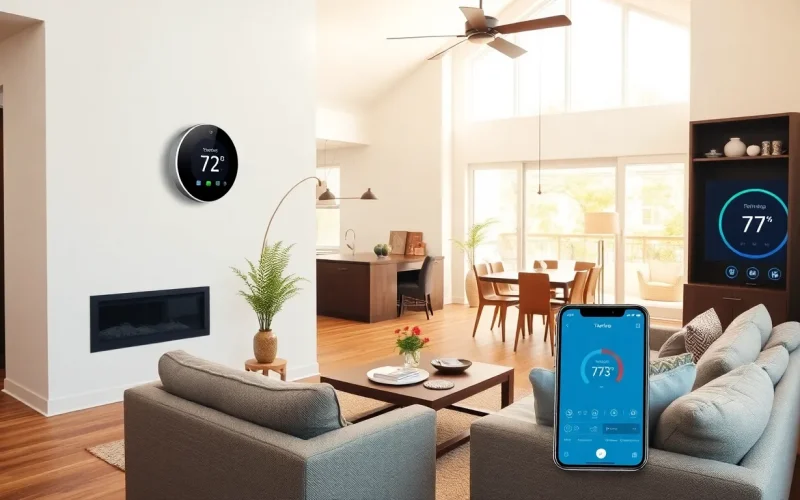Table of Contents
ToggleIn a world where even your fridge might be plotting against you, a smart thermostat stands as a beacon of sanity. Gone are the days of battling with manual dials and guessing if it’s too hot or too cold. With a smart thermostat, you get the power to control your home’s climate right from your pocket, like a modern-day wizard wielding a remote.
Imagine walking into your home, and it’s the perfect temperature, as if your thermostat has been reading your mind. Not only does it keep you comfy, but it also saves you money on energy bills—because who doesn’t want to keep their cash for more important things, like that artisanal cheese? Embrace the future of home comfort and discover how a smart thermostat can transform your living space into an oasis of efficiency and ease.
Overview of Smart Thermostats
Smart thermostats revolutionize home climate control, offering both convenience and efficiency. They enable users to adjust temperatures remotely, enhancing comfort while reducing energy consumption.
What Is a Smart Thermostat?
A smart thermostat is a device that automatically adjusts heating and cooling settings based on users’ preferences and schedules. These gadgets connect to Wi-Fi, allowing control via smartphones or voice commands. Many units feature learning capabilities, adapting over time to individual habits. This adaptability makes them efficient solutions for maintaining optimal home temperatures.
Benefits of Using Smart Thermostats
Smart thermostats offer numerous advantages. Energy savings stand out, as these devices optimize heating and cooling based on real-time data. Users experience increased comfort through precise temperature control. Some models include energy usage reports, helping homeowners identify savings opportunities. Integration with smart home systems enhances overall automation, allowing for seamless management of various devices. Tailored alerts provide maintenance reminders, keeping heating and cooling systems operating efficiently.
Key Features to Consider

Smart thermostats offer various features that enhance home climate management. These functionalities contribute to user comfort, energy savings, and overall convenience.
Energy Efficiency
Energy efficiency stands out as a primary feature of smart thermostats. These devices learn usage patterns and adjust settings to optimize energy consumption. Users experience reduced energy bills due to intelligent scheduling. Many models provide real-time energy usage reports, helping users understand their consumption habits. On average, households can save up to 23% on heating and cooling costs annually with a smart thermostat.
User Interface and Accessibility
User interface and accessibility play crucial roles in the effectiveness of smart thermostats. Intuitive designs ensure users navigate settings effortlessly. Many apps associated with these devices feature user-friendly layouts, allowing quick adjustments, even from remote locations. Voice command functions offer additional accessibility, letting users control settings hands-free. This convenience enhances daily interactions with the thermostat.
Integration with Smart Home Systems
Integration with smart home systems enhances the functionality of smart thermostats. Devices often connect seamlessly with platforms like Amazon Alexa or Google Assistant. Coordinated device management offers users automated routines, improving energy efficiency and comfort. Users benefit from features like adjusting temperature based on occupancy or time of day. Such integration expands the capability of smart thermostats, making them a central part of a smart home ecosystem.
Popular Smart Thermostat Models
Various smart thermostat models stand out for their features, performance, and user satisfaction. This section provides insights into leading models available today.
Comparison of Leading Brands
Nest, Ecobee, and Honeywell serve as prominent players in the smart thermostat market. Nest Learning Thermostat offers self-learning technology and integration with Google Home. Ecobee SmartThermostat includes room sensors, enhancing temperature control throughout the home. Honeywell Home T9 stands out with its compatibility across multiple heating and cooling systems. Each brand emphasizes energy efficiency, allowing users to enjoy significant savings on utility bills throughout the year.
Unique Features of Each Model
Nest Learning Thermostat stands out with its sleek design and auto-schedule feature that learns user habits. Ecobee SmartThermostat provides voice control capabilities and supports Spotify integration, enhancing home entertainment. Honeywell Home T9 boasts Smart Room Sensor capabilities, enabling users to prioritize comfort in occupied spaces. These unique features cater to diverse preferences, making each model suitable for different household needs.
Installation and Setup Process
Installing a smart thermostat can be straightforward for many users. The process includes options for both DIY enthusiasts and those who prefer professional assistance.
DIY Installation vs Professional Help
DIY installation works well for those comfortable with basic electrical tasks. Most smart thermostats come with detailed instructions that simplify the setup. Users typically require a screwdriver and a few basic tools. For individuals uncertain about wiring or home systems, professional help ensures correct installation. Experts assess existing HVAC systems and guarantee compatibility with the smart thermostat, ensuring optimal performance. Professional installation usually ranges from $100 to $200, adding peace of mind.
Initial Configuration Tips
Initial configuration begins with downloading the corresponding app for the smart thermostat. Users must create an account and connect the device to Wi-Fi for remote access. Following the on-screen setup prompts provides a seamless experience. It’s crucial to input home details like temperature preferences and schedules during the setup. This personalization optimizes system performance. For energy efficiency, adjusting settings to reflect realistic occupancy patterns leads to better savings. Updating the thermostat’s firmware regularly ensures it operates with the latest features and improvements.
Smart thermostats represent a significant advancement in home climate control. By combining convenience with energy efficiency they enhance comfort while reducing utility costs. With features like remote access and integration into smart home systems these devices cater to modern lifestyles.
Choosing the right model can elevate a home’s efficiency and comfort level. Whether opting for a DIY installation or seeking professional help the benefits of smart thermostats are undeniable. As technology continues to evolve these devices will only become more integral to creating sustainable and enjoyable living environments. Investing in a smart thermostat is a step toward a smarter home.





